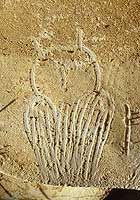
Plate 2
|

Plate 3
|
|
Science
Evaluating avian taxonomy based on an ancient figure etched into the soft surface of a cave wall is a difficult business, and an alternative interpretation is available. It may be that the bird is facing forward and that the species might actually be an Eagle Owl (Bubo bubo). Given Paleolithic artists’ fascination with large and imposing creatures, that conclusion strikes the authors as more plausible. To emphasize the resemblance between the cave image and the Eagle Owl, we have inserted a drawing of its head into the accompanying image (Plate 3).[5]
Other factors--the relative size of the birds, their presence in the cave, and the suite of other cave images--support the alternative hypothesis. Eagle
Owls are the size of eagles and prey on the smaller Long-eared Owls. They nest in caves, whereas Long-ears typically seek abandoned crow nests, found mostly in trees or shrubs. They are also impressive predators: they have been known to take down roe deer, and such accomplishments have earned for members of their genus (Bubo) a reputation as “Tigers of the Air.” In contrast, Long-ears are more commonly preyed upon by others in their tribe. Long-ears have even evolved a defensive posture: They lean forward while arching their wings--like a swimmer poised to dive from a racing block. Then, by lifting the trailing edge of their wings skyward, they frame their face and appear more formidable, the way “owl eyespots” on the wings of certain moths may fool predators into thinking they are too large to take.[6]
page 3--> |
Plate 2 Owl in Chauvet Cave, Vallon–Pont d'Arc, France,
c.30,000 BCE
Plate 3 Modified Owl in Chauvet Cave, Vallon–Pont d'Arc, France, 1997/2007 (Eagle Owl) by Darryl Wheye
© 2008 Darryl Wheye and Donald Kennedy
|


